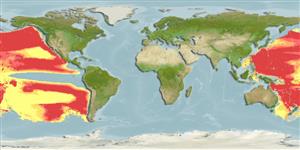Classificação / Names
Nomes comuns | Sinónimos | Catalog of Fishes(Género, Espécies) | ITIS | CoL | WoRMS | Cloffa
>
Lophiiformes (Anglerfishes) >
Oneirodidae (Dreamers)
Etymology: Tyrannophryne: Greek, 'tyrranos' or Latin, 'tyrannus' = tyrant + Greek, 'phryne' = toad (to mean "tyrannical toad" in reference to its menacing look; common name derived from type species T. pugnax) (Ref. 86949 ).
More on authors: Regan & Trewavas.
Environment: milieu / climate zone / depth range / distribution range
Ecologia
marinhas batipelágico; intervalo de profundidade 400 - 2100 m (Ref. 86949). Deep-water
Pacific Ocean: Eastern Central Pacific (Ref. 40966); western and central Pacific, including South Pacific (Ref. 86949).
Tamanho / Peso / Idade
Maturity: Lm ? range ? - ? cm
Max length : 4.7 cm SL (female)
Descrição breve
Morfologia | Morfometria
Raios dorsais moles (total): 5; Raios anais moles: 5. Metamorphosed females distinguished by having an extremely large oblique mouth; elements of upper and lower jaws extending posteriorly far beyond the base of the pectoral fin and opercular opening; vomerine teeth present or absent; well developed sphenotic spines; well-developed symphisial spine on lower jaw; elongate and tapering angular, forming long narrow spine; hypomandibula with two heads; small quadrate spine, however, longer than articular spine; deeply notched posterior margin of opercle; short and broad subopercle, dorsal end rounded, ventral end nearly circular; toothless pharyngobranchial II; caudal fin lacking internal pigmentation; extremely short illicium, almost totally enveloped by tissue of esca in smaller specimens; well developed first ray of dorsal fin; dorsal fin rays 5; anal fin rays 5; short and broad pectoral fin lobe, shorter than longest rays of pectoral fin; pectoral fin rays 18-20; skin naked, lacking dermal spinules; darkly pigmented skin of caudal peduncle extends well past base of caudal fin (Ref. 86949).
Life cycle and mating behavior
Maturidade | Reprodução | Desova | Ovos | Fecundidade | Larvas
Nielsen, J.G., 1974. Fish types in the Zoological Museum of Copenhagen. Zoological Museum of Copenhagen, Denmark. 115 p. (Ref. 38022)
Categoria na Lista Vermelha da IUCN (Ref. 130435)
Ameaça para o homem
Harmless
Utilização humana
Mais informação
Nomes comunsSinónimosMetabolismoPredadoresEcotoxicologiaReproduçãoMaturidadeDesovaAgregação para desovaFecundidadeOvosDesenvolvimento dos ovos
Idade/TamanhoCrescimentoComprimento-pesoComprimento-comprimentoFrequência de comprimentoMorfometriaMorfologiaLarvasDinâmica larvarRecrutamentoAbundânciaBRUVS
ReferênciasAquaculturaPerfil para aquaculturaEstirpesGenéticaElectrophoresesHereditariedadeDoençasProcessamentoNutrientsMass conversion
ColaboradoresFotografiasStamps, Coins Misc.SonsCiguateraVelocidadeTipo de nataçãoÁrea branquialOutras referênciasCérebrosVisão
Ferramentas
Relatórios especiais
Descarregue XML
Fontes da internet
Estimates based on models
Preferred temperature (Ref.
123201): 3.4 - 5.3, mean 4.5 °C (based on 371 cells).
Phylogenetic diversity index (Ref.
82804): PD
50 = 1.0000 [Uniqueness, from 0.5 = low to 2.0 = high].
Bayesian length-weight: a=0.01000 (0.00244 - 0.04107), b=3.04 (2.81 - 3.27), in cm total length, based on all LWR estimates for this body shape (Ref.
93245).
Nível Trófico (Ref.
69278): 3.4 ±0.5 se; based on size and trophs of closest relatives
Resiliência (Ref.
120179): Elevada, tempo mínimo de duplicação da população menor que 15 meses (Preliminary K or Fecundity.).
Fishing Vulnerability (Ref.
59153): Low vulnerability (10 of 100).
